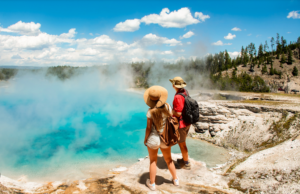
A Journey Through Time The Human History and Cultural Significance of Yellowstone National Park
Yellowstone National Park, established on March 1, 1872, by the U.S. Congress, is renowned as the oldest, one of the largest, and arguably the most famous national park in the United States. Situated primarily in northwestern Wyoming, with portions extending into southern Montana and eastern Idaho, the park is celebrated for its extraordinary concentration of hydrothermal features. Covering an area of 3,472 square miles (8,992 square kilometers), Yellowstone is a UNESCO biosphere reserve and World Heritage site, with its headquarters at Mammoth Hot Springs near the northern entrance.
Natural Environment
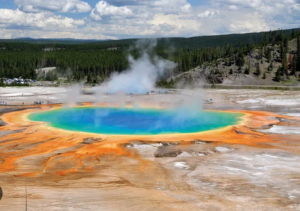
Geology
Yellowstone’s geology is a testament to its volcanic and seismic activity, spanning tens of millions of years. The North American Plate’s tectonic movement has created a hotspot in the region, leading to significant volcanic eruptions. Approximately 2.1 million years ago, a massive volcanic eruption occurred, ejecting around 600 cubic miles (2,500 cubic kilometers) of rock and ash. This eruption, followed by others around 1.3 million and 640,000 years ago, shaped the present-day Yellowstone Caldera, a roughly oval basin measuring about 30 by 45 miles (50 by 70 kilometers).
The region remains seismically active, experiencing hundreds of small earthquakes annually, mostly undetected by humans. However, some quakes, such as the 1959 event in southern Montana, can impact hydrothermal features, including Old Faithful geyser.
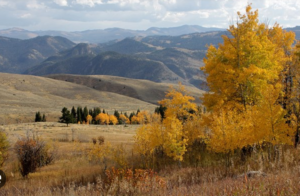
Physical Features
Yellowstone’s landscape comprises broad volcanic plateaus at an average elevation of 7,875 feet (2,400 meters), interspersed with three north-south mountain ranges: the Gallatin Range in the northwest, the Absaroka Range in the east, and the Teton Range’s northern extremity along the southwestern boundary. The Absaroka Range’s Eagle Peak, at 11,358 feet (3,462 meters), is the park’s highest point. The park’s diverse geology includes fossil forests, eroded basaltic lava flows, an obsidian mountain, and unique erosional formations.
The park’s notable water bodies include Yellowstone Lake, the largest, with a surface area of 132 square miles (342 square kilometers) and an elevation of 7,730 feet (2,356 meters). Other significant lakes are Shoshone Lake and the West Thumb area of Yellowstone Lake. The Yellowstone River, the park’s main drainage system, flows northward through Yellowstone Lake, featuring the spectacular Yellowstone Falls and the Grand Canyon of the Yellowstone.
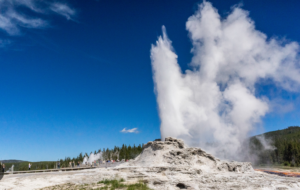
Hydrothermal Features
Yellowstone’s approximately 10,000 hydrothermal features, including geysers, hot springs, mud pots, and fumaroles, are a major draw. Groundwater seeps down to contact the magma, returning to the surface as superheated, mineral-rich water. These features are maintained by the region’s constant minor tremors, which keep cracks and fissures open.
Key hydrothermal areas include the Upper, Midway, and Lower Geyser Basins, Norris Geyser Basin, and Mammoth Hot Springs. Noteworthy features are Old Faithful geyser, which erupts roughly every 90 minutes, Steamboat Geyser, the world’s highest-erupting geyser, and Mammoth Hot Springs’ travertine terraces.
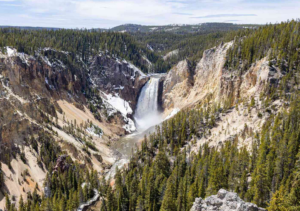
Climate
Yellowstone’s climate is cool temperate and continental, characterized by significant variability due to its high elevation, latitude, continental location, and mountainous terrain. Summers are warm and sunny, with afternoon thunderstorms common. Winters are cold and snowy, with temperatures often dropping below 0 °F (-18 °C). Annual precipitation ranges from 10 inches (250 mm) in the north to 80 inches (2,000 mm) on the northern Teton foothills’ western slopes. Snowfall is heavy, especially at higher elevations.
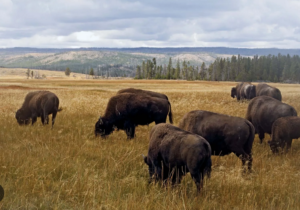
Plant and Animal Life
Yellowstone hosts around 1,350 species of flowering plants, with about 1,150 being native. Forests cover four-fifths of the park, predominantly consisting of lodgepole pines. Other conifer species include whitebark pine and Douglas fir. Various wildflowers, such as phlox, lupines, cinquefoils, larkspurs, and Indian paintbrushes, bloom from April to September.
The park’s diverse fauna includes the largest assemblage of mammals in the contiguous United States, with over five dozen species. Bison, once near extinction, now number several thousand. Other large mammals include elk, mule deer, black bears, foxes, coyotes, grizzly bears, bighorn sheep, pronghorns, mountain goats, and moose. Smaller mammals include badgers, martens, weasels, river otters, hares, shrews, bats, and various rodents. Wolves, reintroduced in 1995, and beavers have made significant comebacks.
More than 300 bird species are found in Yellowstone, with about half nesting there in summer. Notable species include trumpeter swans, Canada geese, sandhill cranes, white pelicans, and common loons. Raptors like bald eagles, ospreys, and peregrine falcons have recovered significantly.
Yellowstone’s lakes and streams support native fish species like cutthroat trout, Arctic grayling, and Rocky Mountain whitefish. Fishing regulations have been implemented to protect these stocks, including catch-and-release policies.
Reptiles and amphibians are fewer in number due to the park’s cold, dry climate. Notable species include prairie rattlesnakes, boreal chorus frogs, and blotched tiger salamanders.
Thermophiles, heat-tolerant extremophiles, thrive in the park’s hydrothermal features, contributing to their distinctive colors. These include prokaryotic algae and bacteria, as well as thermophilic archaea.
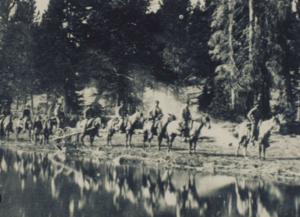
Human History
Archaeological evidence suggests that humans have inhabited Yellowstone for over 11,000 years. Early inhabitants, including the Wind River Shoshone and other groups, lived in or visited the area for hunting, trading, and ceremonies.
The first European to explore Yellowstone was American trapper John Colter in 1807-08. Other trappers and explorers followed, with the first published account appearing in 1827. Official surveys in the 1870s led to proposals for federal protection of the area, culminating in the creation of Yellowstone National Park in 1872.
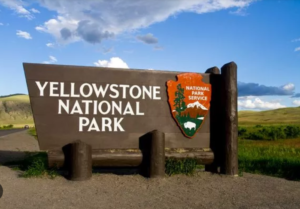
Development of the Park
The park’s first superintendent, Nathaniel P. Langford, faced challenges due to lack of funds. His successor, Philetus W. Norris, made significant contributions, including scientific studies, conservation measures, and infrastructure development. Early travel to the park was difficult, and conflicts with Native Americans persisted until the early 1880s. The Northern Pacific Railroad’s completion facilitated tourism, leading to the construction of hotels and improved infrastructure.
The U.S. Army administered the park from 1886, enhancing protection and infrastructure. The National Park Service (NPS) took over in 1918, increasing scientific exploration and education programs. Park attendance grew steadily, with significant infrastructure developments in the mid-20th century.
Contemporary Park
Post-World War II, automobile travel boosted park attendance, leading to infrastructure renovations under NPS’s Mission 66 program. Recent history includes the 1988 fire, wolf reintroduction in 1995, and annual visits exceeding three million since 1992.
Yellowstone is accessible year-round through various entrances, with extensive facilities for visitors. Activities include hiking, camping, fishing, boating, wildlife watching, and winter sports. Notable hikes include the ascent of Mount Washburn, offering spectacular views from its summit.
Overall, Yellowstone National Park remains a symbol of natural beauty and conservation, attracting millions of visitors annually and preserving its unique geological, ecological, and cultural heritage.